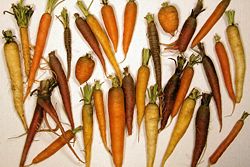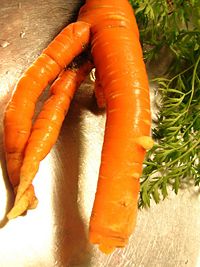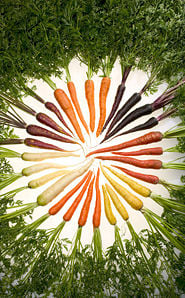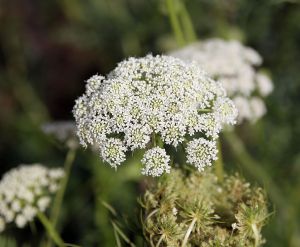Difference between revisions of "Carrot" - New World Encyclopedia
Rick Swarts (talk | contribs) |
Rick Swarts (talk | contribs) |
||
| Line 18: | Line 18: | ||
}} | }} | ||
| − | '''Carrot''' is a herbaceous [[root vegetable]], ''Daucus carota'', in the parsley family (Apiaceae or Umbelliferae), which also includes the similar [[parsnip]]. The term carrot also applies to the long, edible, usually tapering taproot of the domesticated form, ''Daucus carota'' subsp. ''sativus''. | + | '''Carrot''' is a herbaceous [[root vegetable]], ''Daucus carota'', in the parsley family (Apiaceae or Umbelliferae), which also includes the similar [[parsnip]]. The term carrot also applies to the long, edible, usually tapering taproot of the domesticated form, ''Daucus carota'' subsp. ''sativus''. These taproots usually are [[orange (color)|orange]] in color, but may be white or pink in color. They have a crisp texture when fresh. |
| + | Wild carrots are also known as "Queen Anne's lace." | ||
==Description== | ==Description== | ||
| Line 26: | Line 27: | ||
Apiaceae is a large family with about 300 genera and more than 3,000 species. The earlier name Umbelliferae derives from the inflorescence being in the form of a compound "umbel." The small flowers are radially symmetrical with 5 small sepals, 5 petals, and 5 stamens. | Apiaceae is a large family with about 300 genera and more than 3,000 species. The earlier name Umbelliferae derives from the inflorescence being in the form of a compound "umbel." The small flowers are radially symmetrical with 5 small sepals, 5 petals, and 5 stamens. | ||
| − | ''Daucus carota'', known | + | The wild carrot, ''Daucus carota'', known also as ''bishop's lace'' or ''Queen Anne's lace'', is a [[flowering plant]] in the family Apiaceae that is native to [[temperate]] regions of [[Europe]] and southwest [[Asia]]. ''Daucus carota'' subsp. ''sativus'' is the domesticated form of the [[wild carrot]] ''Daucus carota''. It has been bred for its greatly enlarged and more palatable, less woody-textured edible taproot, but is still the same [[species]]. |
| + | [[Image:DSCF0784.JPG|thumb|right|240px|Wild carrot or Queen Anne's Lace]]. | ||
| + | Wild carrot is a variable [[biennial plant]], usually growing up to 1 meter tall and flowering from June to August. The [[umbel]]s are claret-colored or pale pink before they open, then bright white and rounded when in full [[flower]], measuring 3-7 centimeters wide with a festoon of [[bracts]] beneath. Finally, as they turn to [[seed]], they contract and become concave like a bird's nest. This has given the plant its British common or vernacular name, ''bird's nest''. Very similar in appearance to the deadly [[Conium|poison hemlock]], it is distinguished by a mix of bi-pinnate and tri-pinnate [[Leaf|leaves]], fine hairs on its stems and leaves, a root that smells like the cultivated carrots, and occasionally a single dark red [[flower]] in its center. | ||
| − | + | Wild carrot was introduced and naturalized in [[North America]], where it is often known as "[[Anne of Denmark|Queen Anne]]'s lace". It is so called because the flower resembles lace; the red flower in the center represents a blood droplet where Queen Anne pricked herself with a needle when she was making the lace. The function of the tiny red flower, colored by [[anthocyanin]], is to attract insects. Because Queen Anne's lace was naturalized into North America, the United States Department of Agriculture has listed it as a [[noxious weed]]. | |
The edible part of a domesticated carrot, ''Daucus carota'' subsp. ''sativus'' is a [[taproot]]. It grows a rosette of leaves in the spring and summer, while building up the stout taproot, which stores large amounts of [[sugar]]s for the [[plant]] to flower in the second year. The flowering stem grows to about 1 meter tall. | The edible part of a domesticated carrot, ''Daucus carota'' subsp. ''sativus'' is a [[taproot]]. It grows a rosette of leaves in the spring and summer, while building up the stout taproot, which stores large amounts of [[sugar]]s for the [[plant]] to flower in the second year. The flowering stem grows to about 1 meter tall. | ||
| − | |||
| − | |||
| − | |||
| − | |||
| − | |||
| − | |||
| − | |||
| − | |||
| − | |||
| − | |||
| − | |||
| − | |||
| − | |||
| − | |||
| − | |||
| − | |||
| − | |||
| − | |||
| − | |||
| − | |||
| − | |||
| − | |||
| − | |||
| − | |||
| − | |||
| − | |||
| − | |||
| − | |||
| − | |||
==History== | ==History== | ||
| − | The wild ancestors of the carrot are likely to have come from [[Afghanistan]], which remains the | + | The wild ancestors of the carrot are likely to have come from [[Afghanistan]], which remains the center of diversity of ''D. carota'', the wild carrot. Selective breeding over the centuries of a naturally-occurring [[subspecies]] of the wild carrot, ''Daucus carota'' subsp. ''sativus'' has produced the familiar garden vegetable (Rose 2006). |
In early use, carrots were grown for their aromatic leaves and seeds, not their roots. Some relatives of the carrot are still grown for these, such as [[parsley]], [[fennel]], [[dill]] and [[cumin]]. The first mention of the root in classical sources is in the 1st century CE. The modern carrot appears to have been introduced to Europe in the 8-10th centuries; [[Ibn al-Awam]], in [[Andalusia]], describes both red and yellow carrots; [[Simeon Seth]] also mentions both colours in the 11th century. Orange-coloured carrots appear in the [[Netherlands]] in the 17th century.<ref>Dalby, A. (1996). [[Oxford Companion to Food]] ''Siren Feasts: A History of Food and Gastronomy in Greece''. Routledge, ISBN 0-415-11620-1, p. 182</ref><ref>Dalby, A. (2003). ''Food in the Ancient World from A-Z''. ISBN 0-415-23259-7, p. 75</ref> | In early use, carrots were grown for their aromatic leaves and seeds, not their roots. Some relatives of the carrot are still grown for these, such as [[parsley]], [[fennel]], [[dill]] and [[cumin]]. The first mention of the root in classical sources is in the 1st century CE. The modern carrot appears to have been introduced to Europe in the 8-10th centuries; [[Ibn al-Awam]], in [[Andalusia]], describes both red and yellow carrots; [[Simeon Seth]] also mentions both colours in the 11th century. Orange-coloured carrots appear in the [[Netherlands]] in the 17th century.<ref>Dalby, A. (1996). [[Oxford Companion to Food]] ''Siren Feasts: A History of Food and Gastronomy in Greece''. Routledge, ISBN 0-415-11620-1, p. 182</ref><ref>Dalby, A. (2003). ''Food in the Ancient World from A-Z''. ISBN 0-415-23259-7, p. 75</ref> | ||
| Line 104: | Line 78: | ||
[[Image:2005carrot_and_turnip.PNG|thumb|300px|left|Carrot and [[Turnip]] output in 2005. Green: largest producer (China). Yellow: other major producers. Red: minor producers]] | [[Image:2005carrot_and_turnip.PNG|thumb|300px|left|Carrot and [[Turnip]] output in 2005. Green: largest producer (China). Yellow: other major producers. Red: minor producers]] | ||
In 2005, [[China]] was the largest producer of carrots and turnips, according to the [[FAO]]. China accounted for at least one third of the global output, followed by [[Russia]] and the [[United States]]. <br clear=all> | In 2005, [[China]] was the largest producer of carrots and turnips, according to the [[FAO]]. China accounted for at least one third of the global output, followed by [[Russia]] and the [[United States]]. <br clear=all> | ||
| + | |||
| + | |||
| + | ==Uses== | ||
| + | [[Image:Carrot flowers.jpg|left|thumb|Carrot Flowers]] | ||
| + | Carrots can be eaten raw, whole, chopped, grated, or added to [[salad]]s for colour or texture. They are also often chopped and boiled, fried or steamed, and cooked in [[soup]]s and [[stew]]s, as well as fine baby foods and select pet foods. A well known dish is ''carrots [[Julienning|julienne]]''. Grated carrots are used in [[carrot cake]]s, as well as [[carrot pudding]]s, an old English dish thought to have originated in the early 1800s. The greens are edible as a [[leaf vegetable]], but are rarely eaten by humans. Together with [[onion]] and [[celery]], carrots are one of the primary vegetables used in a ''[[mirepoix (cuisine)|mirepoix]]'' to make various [[broth]]s. | ||
| + | |||
| + | Since the late 1980s, [[Baby Carrot|baby carrots]] or mini-carrots (carrots that have been peeled and cut into uniform cylinders) have been a popular ready-to-eat [[snack]] food available in many [[supermarket]]s. [[Carrot juice]] is also widely marketed. | ||
| + | |||
| + | The carrot gets its characteristic orange colour from [[Carotene|β-carotene]], which on consumption by humans is metabolised into [[vitamin A]]. Massive overconsumption of [[carrots]] can cause [[hypercarotinemia]], a condition in which the skin turns orange (although this is superior to overdose effects of vitamin A, which can cause liver damage). Carrots are also rich in [[dietary fibre]], [[antioxidant]]s, and [[dietary mineral|minerals]]. | ||
| + | |||
| + | Lack of Vitamin A can cause poor vision, and better vision can be restored by adding Vitamin A back into the diet. A common [[urban legend]] in part based on this is that carrots aid a human being's [[night vision]]. It is believed that [[disinformation]] introduced in [[1940]] by [[John Cunningham (RAF officer)|John "Cat's Eyes" Cunningham]] during the [[Battle of Britain]] was an attempt to cover up the discovery and use of [[radar]] technologies <ref>{{snopes | link = http://www.snopes.com/food/ingredient/carrots.asp | title = Carrots }}</ref><ref>{{cite web | url = http://www.abc.net.au/science/k2/moments/s1392430.htm | title = Carrots & Night Vision | work = Great Moments in Science | publisher = ABC | author = Kruszelnicki, K. S.}}</ref>. It reinforced existing [[Germany|German]] [[folklore]] and helped to encourage children to eat the vegetable. | ||
| + | |||
| + | [[Ethnomedical]]ly, the roots are used to treat digestive problems, intestinal [[parasite]]s, and [[tonsilitis]]. | ||
| + | |||
| + | [[Falcarinol]], a seventeen-carbon [[diyne]] [[fatty alcohol]] was isolated from carrot and [[red ginseng]] (Panax ginseng). It was shown to have potent anticancer properties on primary [[mammary]] [[epithelial]] cells ([[breast cancer]]). <ref>[http://www.cyberlipid.org/simple/simp0003.htm#10]</ref> | ||
| + | |||
| + | |||
==Trivia== | ==Trivia== | ||
| Line 129: | Line 120: | ||
==References== | ==References== | ||
| − | + | <ref>Rose, F. (2006). ''The Wild Flower Key'' (O'Reilly, C., revised and expanded edition) London: Frederick Warne ISBN 0-7232-5175-4, p. 346</ref><ref>Mabey, R. (1997). ''Flora Britannica''. London: Chatto and Windus ISBN 1-85619-377-2, p. 298</ref> | |
| + | |||
==External links== | ==External links== | ||
Revision as of 23:43, 18 August 2007
| Carrot | ||||||||||||||
|---|---|---|---|---|---|---|---|---|---|---|---|---|---|---|
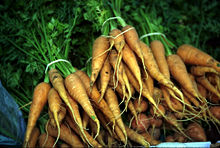 Harvested carrots
| ||||||||||||||
| Scientific classification | ||||||||||||||
| ||||||||||||||
| Daucus carota L. |
Carrot is a herbaceous root vegetable, Daucus carota, in the parsley family (Apiaceae or Umbelliferae), which also includes the similar parsnip. The term carrot also applies to the long, edible, usually tapering taproot of the domesticated form, Daucus carota subsp. sativus. These taproots usually are orange in color, but may be white or pink in color. They have a crisp texture when fresh.
Wild carrots are also known as "Queen Anne's lace."
Description
Daucus carota is a member of the Apiaceae or Umbelliferae family (both names are allowed by the International Code of Botanical Nomenclature). This family comprises unusually aromatic plants with hollow stems, including the cumin, parsley, carrot, parsnip, dill, caraway, fennel, and other relatives. The family also includes some highly toxic plants, such as hemlock.
Apiaceae is a large family with about 300 genera and more than 3,000 species. The earlier name Umbelliferae derives from the inflorescence being in the form of a compound "umbel." The small flowers are radially symmetrical with 5 small sepals, 5 petals, and 5 stamens.
The wild carrot, Daucus carota, known also as bishop's lace or Queen Anne's lace, is a flowering plant in the family Apiaceae that is native to temperate regions of Europe and southwest Asia. Daucus carota subsp. sativus is the domesticated form of the wild carrot Daucus carota. It has been bred for its greatly enlarged and more palatable, less woody-textured edible taproot, but is still the same species.
.
Wild carrot is a variable biennial plant, usually growing up to 1 meter tall and flowering from June to August. The umbels are claret-colored or pale pink before they open, then bright white and rounded when in full flower, measuring 3-7 centimeters wide with a festoon of bracts beneath. Finally, as they turn to seed, they contract and become concave like a bird's nest. This has given the plant its British common or vernacular name, bird's nest. Very similar in appearance to the deadly poison hemlock, it is distinguished by a mix of bi-pinnate and tri-pinnate leaves, fine hairs on its stems and leaves, a root that smells like the cultivated carrots, and occasionally a single dark red flower in its center.
Wild carrot was introduced and naturalized in North America, where it is often known as "Queen Anne's lace". It is so called because the flower resembles lace; the red flower in the center represents a blood droplet where Queen Anne pricked herself with a needle when she was making the lace. The function of the tiny red flower, colored by anthocyanin, is to attract insects. Because Queen Anne's lace was naturalized into North America, the United States Department of Agriculture has listed it as a noxious weed.
The edible part of a domesticated carrot, Daucus carota subsp. sativus is a taproot. It grows a rosette of leaves in the spring and summer, while building up the stout taproot, which stores large amounts of sugars for the plant to flower in the second year. The flowering stem grows to about 1 meter tall.
History
The wild ancestors of the carrot are likely to have come from Afghanistan, which remains the center of diversity of D. carota, the wild carrot. Selective breeding over the centuries of a naturally-occurring subspecies of the wild carrot, Daucus carota subsp. sativus has produced the familiar garden vegetable (Rose 2006).
In early use, carrots were grown for their aromatic leaves and seeds, not their roots. Some relatives of the carrot are still grown for these, such as parsley, fennel, dill and cumin. The first mention of the root in classical sources is in the 1st century CE. The modern carrot appears to have been introduced to Europe in the 8-10th centuries; Ibn al-Awam, in Andalusia, describes both red and yellow carrots; Simeon Seth also mentions both colours in the 11th century. Orange-coloured carrots appear in the Netherlands in the 17th century.[1][2]
In addition to wild carrot, these alternative (mostly historical) names are recorded for Daucus carota: Bee's-nest, Bee's-nest plant, Bird's-nest, Bird's-nest plant, Bird's-nest root, Carota, Carotte (French), Carrot, Common carrot, Crow's-nest, Daucon, Dawke, Devil's-plague, Fiddle, Gallicam, Garden carrot, Gelbe Rübe (German), Gingidium, Hill-trot, Laceflower, Mirrot, Möhre (German), Parsnip (misapplied), Queen Anne's lace, Rantipole, Staphylinos, and Zanahoria. [3]
The parsnip is a close relative of the carrot, as is parsley.
Cultivars
Carrot cultivars can be grouped into two broad classes, eastern carrots and western carrots. More recently, a number of novelty cultivars have been bred for particular characteristics.
Eastern carrots
Eastern carrots were domesticated in Central Asia, probably in modern-day Afghanistan in the 10th century, or possibly earlier. Specimens of the eastern carrot that survive to the present day are commonly purple or yellow, and often have branched roots. The purple colour common in these carrots comes from anthocyanin pigments.
Western carrots
The western carrot emerged in the Netherlands in the 15th or 16th century, its orange colour making it popular in those countries as an emblem of the House of Orange and the struggle for Dutch independence. The orange colour results from abundant carotenes in these cultivars. While orange carrots are the norm in the West, other colours do exist, including white, yellow, red, and purple. These other colours of carrot are raised primarily as novelty crops.
The Vegetable Improvement Center at Texas A&M University has developed a purple-skinned, orange-fleshed carrot, the BetaSweet (also known as the Maroon Carrot), with substances to prevent cancer, which has recently entered commercial distribution.
Western carrot cultivars are commonly classified by their root shape:
- 'Chantenay' carrots are shorter than other cultivars, but have greater girth, sometimes growing up to 8 cm (3 inches) in diameter. They have broad shoulders and taper towards a blunt, rounded tip. They are most commonly diced for use in canned or prepared foods.
- 'Danvers' carrots have a conical shape, having well-defined shoulders and tapering to a point at the tip. They are somewhat shorter than Imperator cultivars, but more tolerant of heavy soil. Danvers cultivars are often pureed as baby food.
- 'Imperator' carrots are the carrots most commonly sold whole in U.S. supermarkets; their roots are longer than other cultivars of carrot, and taper to a point at the tip.
- 'Nantes' carrots are nearly cylindrical in shape, and are blunt and rounded at both the top and tip. Nantes cultivars are often sweeter than other carrots.
While any carrot can be harvested before reaching its full size as a more tender "baby" carrot, some fast-maturing cultivars have been bred to produce smaller roots. The most extreme examples produce round roots about 2.5 cm (1 inch) in diameter. These small cultivars are also more tolerant of heavy or stony soil than long-rooted cultivars such as 'Nantes' or 'Imperator'. The "baby carrots" sold ready-to-eat in supermarkets are, however, often not from a smaller cultivar of carrot, but are simply full-sized carrots that have been sliced and peeled to make carrot sticks of a uniform shape and size.
Carrot flowers are pollinated primarily by bees. Seed growers use honeybees or mason bees for their pollination needs.
Carrots are used as food plants by the larvae of some Lepidoptera species, including Common Swift, Garden Dart, Ghost Moth, Large Yellow Underwing and Setaceous Hebrew Character.
Novelty carrots
Food enthusiasts and researchers have developed other varieties of carrots through traditional breeding methods.
One particular variety lacks the usual orange pigment from carotenes, owing its white colour to a recessive gene for tocopherol (Vitamin E). Derived from Daucus carota L. and patented (US patent #6,437,222) at the University of Wisconsin-Madison, the variety is intended to supplement the dietary intake of Vitamin E.[citation needed]
Production trends
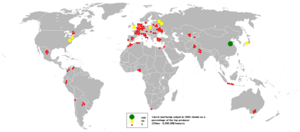
In 2005, China was the largest producer of carrots and turnips, according to the FAO. China accounted for at least one third of the global output, followed by Russia and the United States.
Uses
Carrots can be eaten raw, whole, chopped, grated, or added to salads for colour or texture. They are also often chopped and boiled, fried or steamed, and cooked in soups and stews, as well as fine baby foods and select pet foods. A well known dish is carrots julienne. Grated carrots are used in carrot cakes, as well as carrot puddings, an old English dish thought to have originated in the early 1800s. The greens are edible as a leaf vegetable, but are rarely eaten by humans. Together with onion and celery, carrots are one of the primary vegetables used in a mirepoix to make various broths.
Since the late 1980s, baby carrots or mini-carrots (carrots that have been peeled and cut into uniform cylinders) have been a popular ready-to-eat snack food available in many supermarkets. Carrot juice is also widely marketed.
The carrot gets its characteristic orange colour from β-carotene, which on consumption by humans is metabolised into vitamin A. Massive overconsumption of carrots can cause hypercarotinemia, a condition in which the skin turns orange (although this is superior to overdose effects of vitamin A, which can cause liver damage). Carrots are also rich in dietary fibre, antioxidants, and minerals.
Lack of Vitamin A can cause poor vision, and better vision can be restored by adding Vitamin A back into the diet. A common urban legend in part based on this is that carrots aid a human being's night vision. It is believed that disinformation introduced in 1940 by John "Cat's Eyes" Cunningham during the Battle of Britain was an attempt to cover up the discovery and use of radar technologies [4][5]. It reinforced existing German folklore and helped to encourage children to eat the vegetable.
Ethnomedically, the roots are used to treat digestive problems, intestinal parasites, and tonsilitis.
Falcarinol, a seventeen-carbon diyne fatty alcohol was isolated from carrot and red ginseng (Panax ginseng). It was shown to have potent anticancer properties on primary mammary epithelial cells (breast cancer). [6]
Trivia
- In 2005, a poll of 2,000 people revealed that the carrot was Britain's third favourite culinary vegetable.[7]
- Carrots are noted in popular culture for being the favourite food of rabbits, and are also associated with fictional rabbits, such as Bugs Bunny. However, rabbits finding carrots in a garden are more likely to eat the exposed greens than to dig up the root.
- For the purposes of the European Union's "Council Directive 2001/113/EC of 20 December 2001 relating to fruit jams, jellies and marmalades and sweetened chestnut purée intended for human consumption" carrots can be defined as a fruit as well as a vegetable. This is because carrot jam is a Portuguese delicacy.
- The world's largest carrot was grown in Palmer, Alaska, by John Evans in 1998, weighing 8.614 kg (18.99 pounds).
- The world's largest carrot statue is located in Ohakune, New Zealand.[8]
- Carrots are traditionally used as noses for building snowmen.
- The city of Holtville, California promotes itself as "Carrot Capital of the World", and holds an annual festival devoted entirely to the carrot.
See also
Template:Wikiversity-bc
- List of carrot diseases
- Arracacha
- Carrot fly
- Carrot juice
- Carrot seed oil
- Falcarinol
- Gezer (Hebrew for carrot)
- Parsnip
- Skirret
ReferencesISBN links support NWE through referral fees
External links
- Carrots. The World's Healthiest Foods.
- Daucus carota sativus - Plants For a Future database entry
- Carrot and Garlic Genetics - diverse information on carrots, with links to more (USDA)
- BetaSweet purple carrot. Texas A&M.
- Carrot Cooking and purchasing tips
- Recipes with carrots at the Open Directory Project
- World Carrot Museum
- Processing Carrot Research Program. Nova Scotia Agricultural College.
- Carrots - Nutrional Information. About.com.
Credits
New World Encyclopedia writers and editors rewrote and completed the Wikipedia article in accordance with New World Encyclopedia standards. This article abides by terms of the Creative Commons CC-by-sa 3.0 License (CC-by-sa), which may be used and disseminated with proper attribution. Credit is due under the terms of this license that can reference both the New World Encyclopedia contributors and the selfless volunteer contributors of the Wikimedia Foundation. To cite this article click here for a list of acceptable citing formats.The history of earlier contributions by wikipedians is accessible to researchers here:
The history of this article since it was imported to New World Encyclopedia:
Note: Some restrictions may apply to use of individual images which are separately licensed.
- ↑ Dalby, A. (1996). Oxford Companion to Food Siren Feasts: A History of Food and Gastronomy in Greece. Routledge, ISBN 0-415-11620-1, p. 182
- ↑ Dalby, A. (2003). Food in the Ancient World from A-Z. ISBN 0-415-23259-7, p. 75
- ↑ Nowick, E. A. Daucus carota at Historical Common Names of Great Plains Plants
- ↑ Mikkelson, Barbara & David P. "Carrots" at Snopes.com: Urban Legends Reference Pages.
- ↑ Kruszelnicki, K. S.. Carrots & Night Vision. Great Moments in Science. ABC.
- ↑ [1]
- ↑ Martin Wainwright. Onions come top for British palates. Guardian Unlimited. Guardian Newspapers Limited.
- ↑ staff. Ohakune - Carrot Capital. Ruapehu Bulletin. Ruapehu Bulletin.
- ↑ Rose, F. (2006). The Wild Flower Key (O'Reilly, C., revised and expanded edition) London: Frederick Warne ISBN 0-7232-5175-4, p. 346
- ↑ Mabey, R. (1997). Flora Britannica. London: Chatto and Windus ISBN 1-85619-377-2, p. 298
